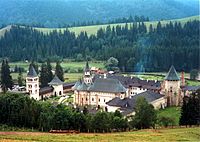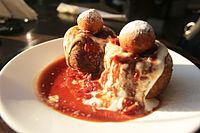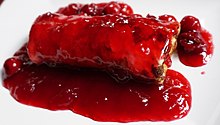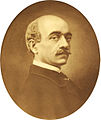Culture of Romania
This article has multiple issues.Please helpimprove itor discuss these issues on thetalk page.(Learn how and when to remove these template messages)
|

| Part ofa serieson the |
| Culture of Romania |
|---|
 |
| People |
| Languages |
| Sport |
Theculture of Romaniais an umbrella term used to encapsulate the ideas, customs and social behaviours of the people of Romania that developed due to the country's distinct geopolitical history and evolution. It is theorized thatRomaniansand related peoples (Aromanians,Megleno-Romanians,andIstro-Romanians) were formed through the admixture of the descendants of Roman colonists[1]and the indigenousPaleo-Balkanicpeople who were subsequentlyRomanized.
Background[edit]

Romania's history has been full of rebounds: the culturally productive epochs were those of stability when the people proved quite an impressive resourcefulness in the making up for less propitious periods and were able to rejoin the mainstream ofEuropean culture.This stands true for the years after thePhanariote-Ottomanperiod, at the beginning of the 19th century, when Romanians had a historical context and Romania started to become westernized, mainly withFrenchinfluences, which they pursued steadily and at a very fast pace. From the end of the 18th century, the sons of the upper classes started having their education inParis,andFrenchbecame (and was until the communist years) a genuine second language of culture for Romanians.
The modeling role of France, especially in the fields of political ideas, administration, and law, as well as in literature, was paralleled, from the mid-19th century down toWorld War I,by German culture as well, which also triggered constant relationships with the German world not only at a cultural level but in daily life as well. With the arrival of Soviet communism in the area, Romania quickly adopted many soviet influences, andRussianwas also widely taught in the country during Romania's socialist years.
History[edit]
Middle Ages[edit]

Until the 14th century, small states (Romanian:voievodate) were spread across the territory ofTransylvania,Wallachia,andMoldavia.The medieval principalities of Wallachia and Moldavia arose in the mid 1300s, in the areas south and east of theCarpathian Mountainsrespectively.
Moldavia and Wallachia were both situated on important commercial routes often crossed by Polish, Saxon, Greek, Armenian,Genovese,andVenetianmerchants, connecting them well to the evolving culture of medieval Europe.Grigore Ureche'schronicle,Letopisețul Țărîi Moldovei(The Chronicles of the land of Moldavia), covering the period from 1359 to 1594, is a very important source of information about life, events, and personalities in Moldavia. It is among the first non-religious Romanian literary texts; due to its size and the information that it contains, it is arguably the most important Romanian document from the 17th century.
The first printed book, a prayer book inSlavonic,was produced in Wallachia in 1508, and the first book in Romanian, acatechism,was printed in Transylvania, in 1544. At the end of the 17th and the beginning of the 18th century, Europeanhumanisminfluenced the works ofMiron CostinandIon Neculce,the Moldavianchroniclerswho continued Ureche's work.Constantin Brâncoveanu,princeof Wallachia, was a great patron of the arts and was a localRenaissancefigure. DuringȘerban Cantacuzino's reign, the monks at the monastery ofSnagov,nearBucharest,published in 1688 the first translated and printed RomanianBible(Biblia de la București– TheBucharest Bible). The first successful attempts at written Romanian-language poetry were made in 1673 whenDosoftei,aMoldavian metropolitaninIași,published a Romanian metricalpsalter.
Dimitrie Cantemir,a Moldavian prince, was an important personality of the medieval period in Moldavia. His interests included philosophy, history, music, linguistics, ethnography, and geography. His most important works containing information about the Romanian regions wereDescriptio Moldaviae,published in 1769, andHronicul vechimii a romano-moldo-valahilor(roughly,Chronicle of the Antiquity of the Romano-Moldavo-Wallachians), the first critical history of Romania. His works were also known in western Europe, as he authored writings in Latin:Descriptio Moldaviae(commissioned by the Academy of Berlin, the member of which he became in 1714) andIncrementa atque decrementa aulae othomanicae,which was printed in English between 1734–1735 (second edition in 1756), in French in 1743 and in German in 1745; the latter was a major reference work in European science and culture up until the 19th century.
Classical Age[edit]


InTransylvania,although they formed the majority of the population, Romanians were merely seen as a "tolerated nation" by the Austrian leadership of the province,[2]and were not proportionally represented in political life and theTransylvanian Diet.At the end of the 18th century an emancipation movement known as theTransylvanian School(Școala Ardeleană) was formed, emphasizing the Roman element of the Romanian people, and making significant strides in the formation of a modern Latin-basedRomanian alphabet(which eventually supplanted an earlierCyrillicscript). It formed following the Act of Union of 1698, which declared the fullcommunionwith theSee of Romeof the Romanian Transylvanian church under MetropolitanAtanasie Anghel.Thus, theRomanian Greek-Catholic Churchwas formed, formalized by a synod of bishops on September 4, 1700. The links with Rome brought to theRomanianTransylvanians the ideas of theAge of Enlightenment.In 1791 the Transylvanian School issued a petition to EmperorLeopold II of Austria,namedSupplex Libellus Valachorumbased on the FrenchDeclaration of the Rights of Man and of the Citizen,demanding equal political rights with the other ethnicities for the Romanians in Transylvania. This movement, however, leaned more towards westernization in general, when in fact, the origin of the Romanian people is complex, intertwining elements from the peoples of the former Roman Empire with those of the ancient Dacians, and with the addition of 17th and 19th Eastern influences as emphasized through the Ottomans.
The period from 1711 to 1821 was marked inWallachiaandMoldaviaby the reigns of appointedPhanarioteHospodars;thus, the two principalities were heavily influenced by the Ottoman and Greek world. Greek schools appeared in the principalities, and in 1818, the first Romanian School was founded in Bucharest byGheorghe LazărandIon Heliade Rădulescu.Figures such asAnton Pann,a successful novelist, emerged in that time, withIenăchiță Văcărescuwriting the firstRomanian grammar,and his nephewIancu Văcărescubecoming what is considered to be the first important Romanian poet. In 1821, anuprising in Wallachiatook place against Phanariote rule. This uprising was led by the Romanian revolutionary and militia leaderTudor Vladimirescu,and would eventually lead to the restoration of Romanian princes on the thrones of theDanubian Principalities.[3]
The revolutionary year 1848had its echoes also in Wallachia, Moldavia and Transylvania, and a new elite had emerged from the revolutions represented by figures such as:Mihail Kogălniceanu(writer, politician, and the first prime minister of Romania),Vasile Alecsandri(politician, playwright, and poet),Andrei Mureșanu(publicist and the writer of the currentRomanian National Anthem) andNicolae Bălcescu(historian, writer and revolutionary).
Theunion between Moldavia and Wallachiain 1859 brought a growing consolidation of Romanian life and culture. Universities were opened inIașiand inBucharest,and the number of new cultural establishments grew significantly. The new prince from 1866 and thenKing of Romania,Carol I,was a devoted king, and he and his wifeElisabethwere among the main patrons of arts. Of great impact in Romanian literature was the literary societyJunimea,founded in 1863 by the circle of literary criticTitu Maiorescu.It published its cultural journalConvorbiri Literarewhere, among others,Mihai Eminescu,Romania's greatest poet,Ion Creangă,a storyteller of genius, andIon Luca Caragiale,novelist and Romania's greatest playwright, published most of their groundbreaking works. During the same period,Nicolae GrigorescuandȘtefan Luchianfounded modern Romanian painting; celebrated composerCiprian Porumbescuwas also from this time.
In Transylvania, the emancipation movement became better organized, and in 1861, an important cultural organization by the name ofASTRA(The Transylvanian Association for Romanian Literature and the Culture of the Romanian People) was founded inSibiuunder the close supervision of the Romanian Orthodox MetropolitanAndrei Șaguna.It helped publish a great number ofRomanian languagebooks and newspapers, and between 1898 and 1904, it published a Romanian Encyclopedia. Among the greatest personalities from this period are the novelist and publicistIoan Slavici,the prose writerPanait Istrati,the poet and writerBarbu Ștefănescu Delavrancea,the poet and publicistGeorge Coșbuc,the poetȘtefan Octavian Iosif,the historian and founder of Romanian press in TransylvaniaGeorge BarițiuandBadea Cârțan,a simple peasant shepherd from Southern Transylvania who, through his actions became a symbol of the emancipation movement.
-
Mihai Eminescu,national poet of Romania and Moldova
Golden Age[edit]

The first half of the 20th century is regarded by many as the golden age of Romanian culture, and it is the period when it reached its main level of international affirmation and a strong connection toEuropean culturaltrends. The most important artist who had a great influence on the world culture was thesculptorConstantin Brâncuși(1876–1957), a central figure of the modern movement and a pioneer of abstraction, an innovator of world sculpture by immersion in the primordial sources of folk creation.
The relationship between traditional and Western European trends was a subject of heated polemics, and outstanding personalities sustained the debates. The playwright,expressionistpoet, and philosopherLucian Blagacan be cited as a member of the traditionalist group and the literary critic founder of the literary circle and cultural journalSburătorul,Eugen Lovinescu,represents the so-called Westernizing group, which sought to bring Romanian culture closer to Western European culture. Also,George Călinescuwas a more complex writer who, among different literary creations, produced the monumental"History of the Romanian literature, from its origins till present day".
The beginning of the 20th century was also a prolific period for Romanian prose, with personalities such as thenovelistLiviu Rebreanu,who described the struggles in the traditional society and the horrors of war,Mihail Sadoveanu,a writer of novels of epic proportions with inspiration from the medieval history of Moldavia, andCamil Petrescu,a more modern writer distinguishing himself through his analytical prose writing. Indramaturgy,Mihail Sebastianwas an influential writer, and as the number of theaters grew, also did the number of actors,Lucia Sturdza Bulandrabeing an actress representative of this period.
Alongside the prominent poetGeorge Topîrceanu,a poet of equal importance wasTudor Arghezi,who was the first to revolutionize poetry in the last 50 years. One should not neglect the poems ofGeorge Bacovia,asymbolistpoet of neurosis, and despair and those ofIon Barbu,a brilliant mathematician who wrote a series of very successful cryptic poems.Tristan TzaraandMarcel Janco,founders of theDadaistmovement, were also of Romanian origin.
Also during the golden age came the epoch ofRomanian philosophywith such figures asMircea Vulcănescu,Dimitrie Gusti,Alexandru Dragomir,andVasile Conta.The period was dominated by the overwhelming personality of the historian and politicianNicolae Iorga,who, during his lifetime, published over 1,250 books and wrote more than 25,000 articles. In music, the composersGeorge EnescuandConstantin Dimitrescuand the pianistDinu Lipattibecame world-famous. The number of important Romanian painters also grew, and the most significant ones were:Nicolae Tonitza,Camil Ressu,Francisc Șirato,Ignat Bednarik,Lucian Grigorescu,andTheodor Pallady.In medicine, a great contribution to human society was the discovery ofinsulinby the Romanian scientistNicolae Paulescu.Gheorghe Marinescuwas an importantneurologistandVictor Babeșwas one of the earliest bacteriologists. In mathematics,Gheorghe Țițeicawas one of Romania's greatest mathematicians, and also an important personality was the mathematician/poetDan Barbilian.
Post-war period[edit]
In Romania, thecommunist regimeimposed heavy censorship on almost all elements of life, and they used the cultural world as a means to better control the population. The freedom of expression was constantly restricted in various ways: the Sovietization period was an attempt at building up a new cultural identity on the basis of socialist realism and lending legitimacy to the new order by rejecting traditional values. Two currents appeared: one that glorified the regime and another that tried to avoid censorship. The first is probably of no lasting cultural value, but the second managed to create valuable works, successfully avoiding censorship and being very well received by the general public. From this period, the most outstanding personalities are those of the writerMarin Preda,the poetsNichita StănescuandMarin Sorescu,and the literary criticsNicolae ManolescuandEugen Simion.Most dissidents who chose not to emigrate lived a life closely watched by the regime, either in "house arrest" or in "forced domicile"; some chose to retreat to remote monasteries. Most of their work was published after the1989 Revolution.Among the most notable examples are the philosophersConstantin Noica,Petre Țuțea,andNicolae Steinhardt.
There was a chasm between the official, communist culture and genuine culture. On the one hand, against the authorities' intentions, the outstanding works were perceived as a realm of moral truths, and the significant representatives of genuine cultural achievement were held in very high esteem by the public opinion. On the other hand, the slogans disseminated nationwide through the forms of official culture helped spread simplistic views, which were relatively successful among some ranks of the population. The tension between these two directions can still be perceived at the level of society as a whole.
Culture inside communist Romania[edit]

A strong editorial activity took place during the Communist regime. With the purpose of educating the large masses of peoples, a huge number of books were published. Large-scale editing houses such asCartea Românească,Editura Eminescu,and others appeared, which published huge collections of books, such as theBiblioteca pentru Toţi( "The Library for Everyone" ) with over 5,000 titles. Generally, a book was never published in an edition of less than 50,000 copies. Libraries appeared in every village, and almost all were kept up to date with the newest books published. Also, due to low prices, almost everyone could afford to have their own collection of books at home. The negative part was that all the books were heavily censored. Also, due to rationing in every aspect of life, the quality of the printing and the paper also was very low, and the books, therefore, degraded easily.
During this period, there was a significant increase in the number of theatres, as they appeared even in the smallest towns. Many new establishments were built, and in the big cities they became important landmarks, such as the building of theNational Theatre of Bucharest,situated right in the middle of the city, immediately adjacent toRomania's kilometre zero.In the smaller towns, there existed the so-called "Worker's Theatre", a semi-professional institution. Partly due to the lack of other entertainment venues, the theatre was highly popular, and the number of actors increased. All of the theatres had a stable, state-funded budget. Again, however, the drawback was the heavy control imposed on them by the regime: censorship was ever-present, and only ideologically-accepted plays were allowed. More progressive theatres managed to survive in some remote cities that became favorite destinations for young actors, but they generally had only a local audience.
Cinemas evolved the same way as the theatres; sometimes, the same establishment served both purposes. Movies were very popular, and from the 1960s, foreign films started becoming quite widespread.Westernfilms, when shown, were heavily censored: entire sections were cut, and dialogue was translated only using ideologically accepted words. Domestic or "friendly" foreign productions constituted the bulk of films in cinemas. During this period, cinematography started to develop in Romania, and the first successful short films were made based onCaragiale'splays. Financed by the government, during the 1960s, a whole industry developed atBuftea,a town close toBucharest,and some films, especially gangster,Western-genre,and historical movies, were very well received by the public. The most prolific director wasSergiu Nicolaescu,and probably the most-acclaimed actor from that period wasAmza Pellea.
Romanians in exile[edit]
A consequence of the communist attitude towards the bourgeoisie elites in general, was the creation, for the first time in Romania's history, of adiaspora.Three individuals emerged as the most important Romanians abroad: playwrightEugen Ionescu(1909–1994) (who became known in France as Eugène Ionesco), creator of theTheatre of the Absurdand eventual member of theAcadémie française;religious historian and writerMircea Eliade(1907–1986); and the essayist and philosopherEmil Cioran(1911–1996), the greatest French-writing master of style after Pascal. Fellow RomanianIoan Petre Culianucontinued Eliade's work with great success, in the United States. Another member of the diaspora who distinguished himself was the philosopher and logicianStephane Lupasco. The communist rule in Romania, unlike most of the other countries of the Eastern bloc, permanently repudiated the Romanians who had left their country and labeled them as traitors to the motherland. So, neither Mircea Eliade, nor Eugène Ionesco, nor Emil Cioran, whose works would be published in this country sporadically after 1960, could see their native land again. It was only after 1989 that the process of regaining the values of the diaspora and of reintegrating its personalities into this country's culture could be started seriously, a process marked in its turn by tension and disagreements.
Well-known Romanian musicians outside of Romania during this period include conductorsSergiu Celibidache—the main conductor at theBerlin Philharmonic Orchestraand later ofMunich Philharmonic Orchestra—andConstantin Silvestri,main conductor at theBournemouth Symphony Orchestra.Gheorghe Zamfirwas a virtuoso of thepan pipesand made this instrument known to a modern worldwide audience, and was also a composer or interpreter for a great number of movies. Composer and architectIannis Xenakiswas born in Romania and spent his childhood there.
George Emil Palade,acell biologistand a teacher, became the first Romanian to receive theNobel Prize,winning the 1974Nobel Prize in Physiology or Medicinefordescribing the structure and function of organelles in cells.Elie Wiesel,who received theNobel Peace Prizein 1986, was born in the Romanian town ofSighetu Marmaţiei.
Evolutions after 1989[edit]
The fall of soviet-style communism in 1989 elated the cultural world, but the experience hasn't been an easy one due to problems in the transition period and the adoption of a free market economy. The discontinuation of state and political control of culture brought about the long dreamt freedom of expression, but, at the same time, the state subsidies also stopped, and Romania's culture was seriously affected by the side-effects of the incipient, still very imperfect, free-market economy and by inadequate material resources. Culture has had to cope with a variety of problems, one of them being a shift in people's interest towards other areas such as the press and television. The search for a new cultural policy, relying on decentralization, seems to prevail now. People speak about a crisis of culture in this country, but if there is a crisis of culture, it is only at an institutional level.

After thefall of communism in 1989,there was an almost immediate explosion of publication of books previously censored by the regime. Books were published in huge numbers per edition, sales were high, and a great number of publishing houses appeared. However, this soon reached a saturation point, and publishing houses began to decline due to a combination of bad management, a rapid drop in sales, and the absence of subsidies. Many closed after publishing only a few titles; some changed their profile and started printing commercial literature – mainly translations – and the state-owned publishers entered a "state of lethargy". The latter survived due to state financing, but their publishing activity diminished. Despite this, some publishing houses managed to survive and develop by implementing market-oriented policies, and by improving the quality and overall appearance of the books they published. Among the most notable contemporary Romanian publishers areHumanitasin Bucharest,Poliromin Iași, andTeora,which specializes in technical topics and dictionaries. Some publishing houses developed their own chains or bookstores, and also other new, privately owned bookstore chains opened, replacing the old state-owned ones.
Culturally oriented newsprint periodicals followed a similar trajectory of boom and bust. A few have survived and managed to raise their quality and to maintain a critical spirit despite the hardships they encountered.Dilema Veche(Old Dilemma) andRevista 22(Magazine 22) remain respected forces in Romanian culture, withObservator Culturala lesser, but also respected, weekly paper. Also, a state-financed radio (Radio România Cultural) and a television channel (TVR Cultural) with a cultural programme exist, but they are not highly popular.
Many new young writers appeared, but due to financial constraints, only those who have gained a strong reputation could get the financial backing to publish their works. TheWriters's Union,which should, in principle, support these writers' efforts, hasn't undergone much change since 1989, and there is much controversy surrounding its activity and purpose. The most successful writers, likeMircea Cărtărescu,Gabriela Adamesteanu,Mircea Dinescu,Ana Blandiana,Doina Ruști,Radu Aldulescu,Claudiu Komartinetc
Horia-Roman Patapievici,Andrei Pleşu,Gabriel Liiceanu,andHerta Müller,are respected personalities in Romanian life, but they have to devote some of their would-be writing time to other activities, mainly journalism. The ties with the Romanian diaspora are now very strong, and even foreign-language Romanian writers likeAndrei Codrescu(who now writes primarily in English) are very popular.
Romanian theatre also suffered from economic hardships, and its popularity decreased drastically due to the increased popularity of television and other entertainment channels. Some theatres survived due to their prestige (and some continued subsidies); others survived through good management, investing in themselves, and earning a steady audience through the high quality of their productions. Experimental or independent theatres appeared and are quite popular in university cities.Uniter–The Romanian Theatres Association– gives yearly awards to the best performances. Some of the most critically acclaimed directors in contemporary Romania areAndrei Șerban,Silviu Purcărete,Mihai Măniuțiu,Gábor Tompa,Alexandru Dabija,Victor Ioan Frunză,Radu AfrimandAlexandru Darie.Also, among the most appreciated actors, both from the new and old generation, one can nameȘtefan Iordache,Victor Rebengiuc,Maia Morgenstern,Marcel Iureș,Horațiu Mălăele,Ion Caramitru,Mircea Diaconu,Marius Chivuand others.
Due to the lack of funds, Romanian film-making suffered heavily in the 1990s; even now, as of 2005, a lot of controversy surrounds state aid for movies. Well-known directors such asDan PiţaandLucian Pintiliehave had a certain degree of continued success, and younger directors such asCristian Mungiu,Nae Caranfil,Cristi Puiu,Corneliu Porumboiu,Radu JudeandRadu Munteanhave become highly respected. Caranfil's filmFilantropicaand Puiu'sThe Death of Mr. Lăzărescuwere extremely well received and gained awards at international festivals in Paris andCannes.Besides domestic production, Romania became a favorite destination for international producers due to the low cost of filming there, and big investments have been made in large studios.

The number of cultural events held yearly in Romania has increased over the past few years. Some sporadic events like the "2005 BucharestCowParade"have been well received, and yearly events and festivals have continually attracted interest. Medieval festivals held in cities in Transylvania, which combine street theatre with music and battle reenactments to create a very lively atmosphere, are some of the most popular events. In theatre, a yearly National Festival takes place, and one of the most important international theatre festivals is"The Sibiu Theatre Festival",while in filmmaking, the"TIFF" Film FestivalinCluj,the"Dakino" Film FestivalinBucharestand the"Anonimul" Film Festivalin theDanube Deltahave an ever-stronger international presence. In music, the most important event is the"George Enescu" Classical Music Festival,but festivals like"Jeunesses Musicales" International FestivalandJazzfestivals inSibiu,Cluj and Bucharest are also appreciated. An important event took place in 2007 when the city of Sibiu was, along withLuxembourg,theEuropean Capital of Culture.
Culture[edit]
Folklore in Romania
Southern traditional Romanian costumes from Bucharest, late 19th century
The most striking thing about Romanian culture is the strong folk traditions which have survived to this day due to the rural character of the Romanian communities, which has resulted in an exceptionally vital and creative traditional culture. Romania's rich folk traditions have been nourished by many sources, some of which predate theRomanoccupation. Traditional folk arts includewood carving,ceramics,weaving,and embroidery of costumes, household decorations,dance,and richly variedfolk music.Ethnographers have tried to collect in the last two centuries as many elements as possible: theMuseum of the Romanian Peasantand theRomanian Academyare currently the main institutions which systematically organize the data and continue the research of these elements.
The wood used to be the main construction material, and heavily ornamented wooden objects were common in old houses. InMaramureș,wood was used to create impressive structures such as churches or gates; inDobruja,windmills were made of wood, and in mountainous regions, hardwood was used even for covering the roof. To preserve traditional houses, many village museums have been created in the last century throughout Romania, such as theVillage MuseuminBucharest,theTraditional Popular Civilization ASTRA MuseuminSibiu,or theOltenian Village MuseuminRâmnicu Vâlcea.
Linenwas the most common material for clothing, combined withwoolduring the winter or colder periods.These clothes of linen and wool would then be embroidered with traditional motifs that vary from region to region. TheRomanian traditional dressis still worn and created in this fashion around the rural areas of the country. Black is the most common color used, but red and blue are predominant in certain areas. Traditionally, men wore a white shirt and pants with a wide leather belt, usually over the shirt, and a vest sometimes made of leather and embroidered. They wore either boots or simple sandals made of leather calledopinci,and they often wore a hat differing in design from region to region. Women also wore a white skirt and a shirt with a vest. They also traditionally wore an apron which had also been embroidered, and a variety of different headscarfs; on special occasions, they wore more elaborate outfits.
Musicanddancerepresent a lively part of theRomanian folklore,and there are a great variety of musical genres and dances. Party music is very lively and shows bothBalkanandHungarianinfluences. Sentimental music, however, is the most valued, and Romanians consider theirdoina(a sad song either about one's home or about love, composed like an epic ballad) unique in the world.Maria Tănase,Maria Lătărețu,Maria Ciobanu,andIleana Sararoiuare considered to be some of the greatest Romanian folk singers, and todayGrigore LeșeandTaraful Haiducilorare two of the most significant representatives of such styles. The dances are lively and are practiced throughout Romania by a large number of professional and amateur groups, thus keeping the tradition alive;Horais one of the most popular peasant group dances, but more complex dances such as the ritual danceCăluș,danced originally by the Călușari, have been declared byUNESCOto be "Masterpieces of the Oral and Intangible Heritages of Humanity".
Mythology[edit]

Romanians have had, from time immemorial, a myriad of customs, tales, and poems about love, faith, kings, princesses, and witches. The ethnologists, poets, writers, and historians have tried in recent centuries to collect and to preserve tales, poems, ballads and have tried to describe as well as possible the customs and habits related to different events and times of the year. Customs related to certain times of year are thecolinde,RomanianChristmas carols,sorcovaon New Year's Eve, or theMărțișorcustom on the first day of March, marking the spring. Other customs are presumably of pre-Christianpaganorigin, like thePaparudarain enchanting custom in the summer, or the masked folk theatre orUrsul(the bear) andCapra(the goat) in winter.
Perhaps the most successful collector of folk tales was the novelist and storytellerIon Creangă,who in very picturesque language, shaped into their now-classic form stories likeHarap Alb( "The White Moor" ) orFata babei și fata moșului(roughly, "The old woman's daughter and the old man's daughter" ).
Also, the poetVasile Alecsandripublished the most successful version of the balladMiorița(The Little Ewe), a sad, philosophical poem, centered on a simple action: the plot by two shepherds to kill a third shepherd because they envied his wealth. Another prolific editor of folk tales wasPetre Ispirescu,who, in the 19th century, published an impressive number of volumes containing a large number of short novels and tales from popular mythology. They are centered on popular characters like the princeFăt-Frumos(the Romanian "Prince Charming"), the princessIleana Cosânzeana,the villain or monsterZmeuorCăpcăun,the dragonBalaur,or fantastic superbeings like the goodZânăand the evilMuma Pădurii.
Spirituality and religion[edit]



Romanian spirituality is greatly influenced by its strong connections with theEastern Christianworld. The modern national mythology contends Romanians areAn island of Latinity in a Slavic seaandThe onlyOrthodox ChristianLatin people.There are only a few Romanian Catholics (of both the Roman and Greek rites) and a small number ofProtestants,the vast majority of Romanians beingRomanian Orthodox(over 81%).[4]Despite the diminishing importance of the church in recent generations, it remains the most trusted institution in Romania. Church attendance is high in rural communities and among the elders in the cities. Also, despite accusations of collaborationism with thecommunist regime,which continue to plague the Romanian Church, some clerics such asDumitru Stăniloaeand Richard Wurmbrand openly protested against political interventions in religious business. There are also someMuslimsliving in the country.

Romanian Orthodox monasteries and churches exist throughout Romania, but traditionally, few are constructed on a monumental scale. A great number of wooden churches are still intact in theCarpathian Mountainsvillages, but by far, the most impressive is theWooden Churches of Maramureș,which push wood building technique to its limits. Byzantine influences can be found in most Romanian church buildings, but domestic styles have evolved in different periods of time and in different regions. InMoldavia,a particular style was used in the construction of the monasteries, of which some of the most important are thechurches of northern Moldavia–UNESCOWorld Heritage Sites,such as those ofMoldovița,Putna,Sucevița,orVoroneț.InWallachia,Curtea de Argeș Cathedralwas built in aByzantinestyle with Moorish influences, and a great number of churches show Greek influences, especially those built in the 18th century, such asStavropoleos Churchin central Bucharest. Romania also evolved the distinctiveBrâncovenescstyle: the monasteries ofSnagovand ofSâmbăta de Susin Transylvania are classic examples.
Cuisine[edit]






The cuisine of Romania has the same influences as the rest of Romanian culture; from Roman times, there still exists the simple pie called, inRomanian,plăcintăand keeping the initial meaning of the Latin wordplacenta.[5]The Turks broughtmeatballs(friedmititeiorperişoarein a soup calledciorbă); from the Greeks, there is themusaca(moussaka) andcovrigi(hotpretzels); from the Bulgarians, a wide variety of vegetable dishes likezacuscă;from the Austrians there is theşniţel(schnitzel); from the Hungarians, their ornate pastries; and the list could go on.
Without a doubt, one of the most popular dishes in Romania, and perhaps can be called the national dish, isSarmale,orSarmain other cultures of the Balkans, and theCaucasus;a mixture of pork, beef, and lamb, or just plain pork, with onions and rice, wrapped in semi-sour cabbage or grape leaves, and then placed usually in a porcelain pot with tomato paste and pork cuts. This dish is then slow-cooked, and commonly served withcornmeal(mămăligă,which is a type ofpolenta). One of the most common meals is themămăligă,a cornmeal mush, for a long time considered the "poor man's meal" (N-are nici o mămăligă pe masă– "He hasn't even a mămăligă on the table" ), but it has become very appreciated in recent times.Porkis the main meat used in Romanian cuisine, but alsobeefis consumed and a good lamb or fish dish is never to be refused. In conjunction with special events or periods, different recipes are prepared.
DuringChristmas,nearly every family slaughters apigand cooks it using a wide variety of traditional recipes likecârnați– a type of long sausage with meat;caltaboși– sausages made with liver and other internal organs;piftie– a jelly made from parts like the feet, head and ears;tochitură(a kind of stew) – served along with mămăligă andwine( "so that the pork can swim" ); andtobă(head cheese). The meal is sweetened with the traditionalcozonac(sweet bread with nuts, poppy seeds orlokum–rahatin Romanian, known in English asTurkish delight).
Lambis traditional forEaster;the main dishes areborș de miel(lamb sour soup), roast lamb, anddrob– a cooked mix of offal, meat and fresh vegetables, which is quite similar to Scottishhaggis,served withpască(a pie made with cottage cheese) as a sweetener.
Wineis the main drink and has been a tradition for over three millennia. Romania is currently the world's ninth-largest wine producer, and exports have increased in recent years. A wide variety of domestic (Grasă,Tămâioasă) and worldwide (Italian Riesling,Merlot,Sauvignon blanc,Cabernet Sauvignon,Chardonnay,Muscat Ottonel) varieties are produced. Romania is the world's second-largest grower ofplums,and almost all of those plums become either the famousțuică(a once-refined plum brandy) orpalincă(twice-or-more-refined plum brandy).Beeris also highly appreciated, generallyblonde pilsener beer,after the German style.
A great number of proverbs and sayings have developed around the activity of eating. From the innocent child's thank you:Săru-mâna pentru masă, c-a fost bună şi gustoasă, și bucătăreasa frumoasa( "Thank you for the meal, it was good and tasty, and the cook was beautiful" ), to the more philosophicalMulțumescu-ți ție Doamne, c-am mâncat și iar mi-e foame( "Thank you Lord, for I have eaten, but I am hungry again" ),Dragostea trece prin stomac( "Love passes through the stomach" ), the simplePofta vine mâncănd( "Appetite comes while eating" ), the sarcasticPorcul mănâncă orice, dar se-ngrașă pentru alții( "The pig would eat anything but it gets fat for others" ), or the expression of total fulfillment,Mâncat bine, băut bine, dimineața sculat mort( "Ate well, drank well, in the morning woke up dead" ).
Romanian script[edit]

During the 16th century, Romanian first appeared in writing, usually in religious texts and other written documents. A letter dating from 1521, from Neacșu of Câmpulung to the mayor of Brașov, is considered to be the earliest known text written in Romanian. The letter was written in a script which was used mainly in Wallachia and Moldavia until the year 1859. This script was a version of the Old Church Slavonic alphabet, a version of theCyrillic alphabet.
A version of the Cyrillic alphabet was used in theMoldavian Soviet Socialist Republicuntil 1991, when they switched to the Romanian version of the Latin alphabet.
Contribution of the minorities[edit]

Minorities have made a major cultural contribution to Romania. Influences came from, most notably, minority groups such asGermans,Greeks,Italians,andHungarians.TheSzékelyand theSaxonsliving in Transylvania,Hungariansin thePartiumandBanatregions, and theJasz peopleandCsángosinWestern Moldavia,made many important architectural contributions to the region, including numerous churches, fortifications, and town centers. Also, they figured in some landmarks in the development of ethnic Romanian culture: the first letter written in Romanian was addressed to the mayor of Kronstadt (Romanian:Brașov), and the first book printed in Romanian was in Hermannstadt (Romanian:Sibiu). Romania was once also the cradle ofYiddish theatre,and to this day, Bucharest is home to aState Jewish Theater,despite the small number ofJewsremaining in the country.
Architecture and engineering[edit]
In the technical domain, one can note the achievements in the field of aviation made byTraian Vuia,Aurel Vlaicu,Aurel Persu,andHenri Coandăand also the works ofGeorge Constantinescuin the fields of engineering andsonics.Also, many achievements have been made in the architectural and engineering domain; thus,Bucharestbecame known asthe small Paris.The longest bridge in Europe was constructed byAnghel Saligny,linkingDobrujawith the rest of Romania; thePeleș Castlebecame one of the most beautiful and modern castles in Europe.
-
Ancient Dacian ruins atSarmizegetusa Regia
-
Mogoșoaia Palace,view from the garden
-
King Carol I bridge
-
Early airplane model – theA Vlaicu III
Media and television[edit]
Music[edit]

Folk music is the oldest form of Romanian musical creation, characterized by great vitality; it is the defining source of the cultured musical creation, both religious and lay. Conservation of Romanian folk music has been aided by a large and enduring audience, and by numerous performers who helped propagate and further develop the folk sound. Two of them, Vasile Pandelescu, and Dumnitru Zamfira are some of the most famous examples of Romanian folk musicians.
Before the major incorporation of more modern instruments that found their way into Romanian folk music, older instruments such as the Tobă (double-headed drum, also known as the Tabul or Davul), Surlă (also known as the Zurna in other parts of the Balkans), Caval (ancient shepherd's pipe),Cobza(an ancient instrument related to the Arabic Oud), Vioară (violin), Cimpoi (Balkan bagpipe), and the Tamburină (tambourine, more commonly used during the times under Phanariote and Ottoman influence), were also commonly used in folk music before the introduction on some slightly more modern elements such as the widely used accordion, and clarinet. Folk music, often is accentuated with clapping, yells of tongue rolling, shouts, and whistles.
The religious musical creation, born under the influence of Byzantine music adjusted to the intonations of the local folk music, saw a period of glory between the 15th-17th centuries, when reputed schools of liturgical music developed within Romanian monasteries. Russian and Western influences brought about the introduction of polyphony in religious music in the 18th century, a genre developed by a series of Romanian composers in the 19th and 20th centuries.
See also[edit]
- Languages of Romania
- Literature of Romania
- Architecture of Romania
- Cinema of Romania
- Famous Romanian people
- Romanian humour
- Byzantium after Byzantium,a cultural movement which sprung during the medieval Romanian history.
- Sport in Romania
- Culture of Moldova
References[edit]
- ^Gábor, Vékony (2000).Dacians, Romans, Romanians(1st English ed.). Matthias Corvinus.ISBN1882785134.OCLC45414663.
- ^Ilinca., Zarifopol-Johnston (2009).Searching for Cioran.Johnston, Kenneth R. Bloomington: Indiana University Press.ISBN9780253003454.OCLC536278659.
- ^"Tudor Vladimirescu | Walachian leader".Encyclopedia Britannica.Retrieved2018-08-26.
- ^"Populația stabilă după religie – județe, municipii, orașe, comune".Institutul Național de Statistică(in Romanian).
- ^"Bucătăria românească. Istoria gastronomiei românești".Hendi(in Romanian).Retrieved2020-09-09.
External links[edit]
Sibiu International Theatre Festival:https://www.youtube.com/watch?v=VSfSH16tFXU
- cIMeC – The Institute For Cultural Memory,a key Romanian cultural institution.
- https://web.archive.org/web/20071231125142/http://www.itcnet.ro/folk_festival/culture.htm Romania -Cultureon itcnet.ro
- Constantin Brâncuși biographical noteson brancusi.com
- Cultural aspects,an extensive site on ici.ro about Romanian culture.
- Official Romanian Travel and Tourism Information website
- Sibiul.ro,an extensive site about Sibiu (in Romanian)
- Onlinegallery.roNews, events, venues and extensive coverage of Romanian cultural acts
- Manuela Preoteasa,Televiziunea din Romania – dominata de divertisment si non-stiri( "Television in Romania – domination by entertainment and non-news" ), 30 November 2005, in a mix of Romanian and English.
- Romanian spirituality(mostly in Romanian, some portions translated into English)
- Calusul in Lista Capodoperelor Omenirii( "Thecalusdance in the list of Masterpieces of the Oral and Intangible Heritages of Humanity ") (in Romanian)
- Trust in the Church and the Army(in Romanian)
- Romanian recipes
- SOS Romania News
- Romanian folk costumes
- Traditional costume in RomaniaArchived2013-09-26 at theWayback Machine
- Lost Trails web site has free downloads of Romanian folk music and Photography of many Romanian villages
- Romania – cultural and regional differences
- Rolandia– Travel agency that blogs about Romania's culture and traditions






















































